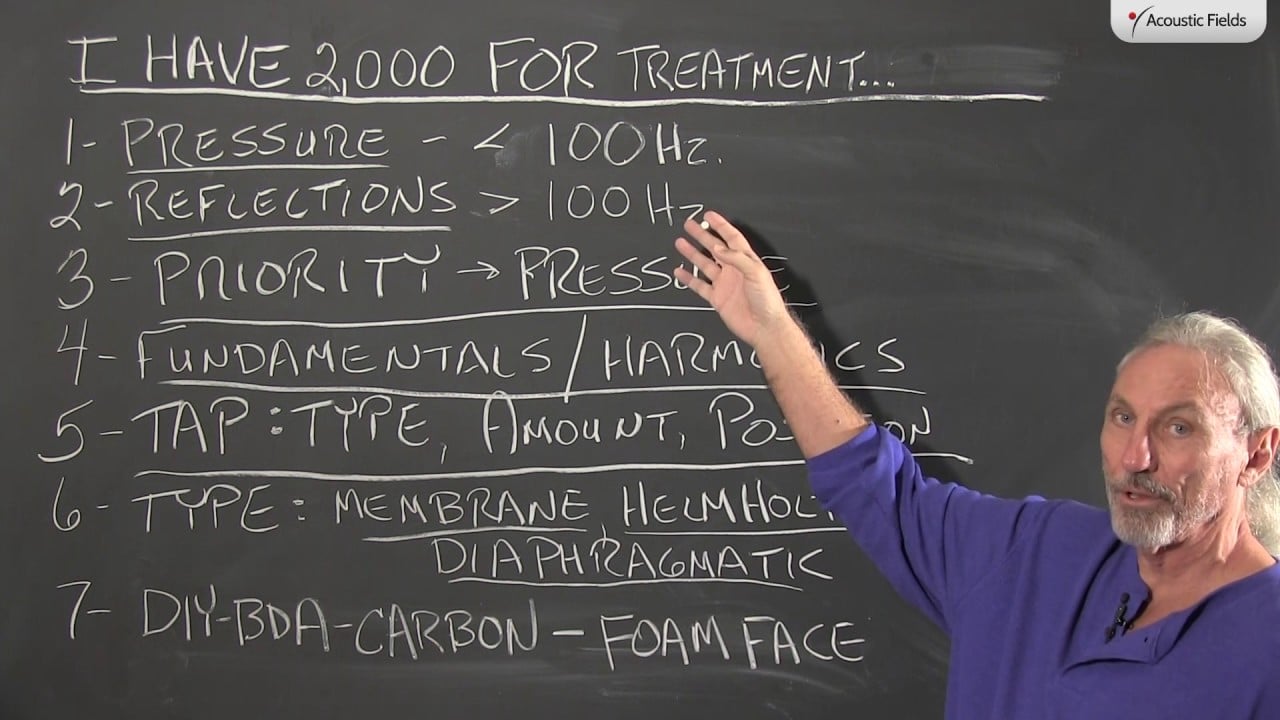I get a lot of calls and emails from people say Dennis I just don’t have budget to treat my room but I know my room has a lot of problems so what can I do. What we’re going to do a series of videos here 1,000 2,000 3,000 what do you have in treatment. Now you’ve got to realize for this kind of money that you’re going to have to have a carpentry skill set, you’re going to have to build things yourself and save the labor costs because acoustic treatment is all about type amount and position. So you’ve got to build the right type, you’ve got to have the right amount and you got to put it in the right spot.
That all takes a lot of units, I mean treatment costs in professional Studios can run fifty to a hundred thousand dollars. Some of our projects are two three hundred thousand with treatment. So what can we do in our small rooms on a limited budget? So let’s say we have two thousand dollars, well we know our two areas of concern are pressure and reflection, now with two thousand dollars we’re not going to be able to address all the issues so we have to break it apart. Low frequency issues are the worst, they’re the most expensive to treat, they take the most amount of product and cover the most surface area so the bottom line is we’ve got to address that first so pressure is going to be our first priority. With pressure we have the low frequency issue and then we have all the harmonics so we may have a 40 cycle problem and then we got 80, 120, 160, 200… so we got all that going on, type, amount, position…
So what are our options for low frequency? We know that it’s membrane, Helmholtz and diaphragmatic. Helmholtz is difficult to build, frequency specific, need a lot of units got to put them in a lot of places in the room. Membrane and diaphragmatic are broadband but diaphragmatic has the most horsepower of the two and then with our carbon technology you can get a lot of horsepower in a small amount of space. So what are we going to do with $2000? How are we going to dress this? Well we’re going to focus on the low frequency pressure first and then we’re going to have to build the unit’s ourselves and you know from our website that we offer a whole series of DIY build units and in this particular case we’re going to build the unit that’s called the BDA and it’s in the DIY section of our website, just go to shop under the DIY section. Now the thing about the BDA is the units are 2 foot x 4 foot, you can make them bigger depending on what your skill set is and what kind of shop you have to build them.
You do need a carpentry skill set to build them, you need to be able to run a table saw. So what are we going to do with $2000? Let’s just walk through an example of how this would work, the build materials in most areas per unit is about $150, it’s mostly 1 inch MDF, ½ inch MDF, 3/8 inch MDF okay. The carbon technology which we can license and sell to you runs about $350 a units so for $500 a unit and your labor you can have four units for $2000 alright. So if you want to stretch a little bit then we can add foam to the face of each unit to then start to manage the reflections. So if we have $2,000 you know we can build four units and we could get enough horsepower in terms of square footage to do something so break your room requirements down in the low-frequency issues and reflection and let’s treat the low frequency issues first. Is 4units in most small room going to be enough? No but it’ll be a start and you can phase it in especially when you have a limited budget.
—
This is an unedited transcript from our video series from Acoustic Fields. There will be some errors in grammar and sentence structure that occur during this translation process.
For complete understanding and comprehension, please view the video which is included in this text. For any additional information regarding this topic or others relating to room acoustics, please contact us directly at:
P: 520 – 392 – 9486







